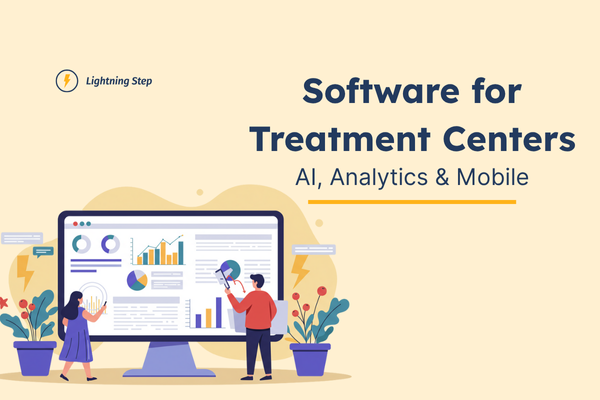
The healthcare landscape continues to change at a rapid pace. Treatment centers now face increasing demands for efficiency, accuracy, and personalized care. Technology offers solutions to these challenges through innovative software systems that transform how centers operate and deliver care.
Modern software for treatment centers now incorporates AI capabilities, mobile functionality, and sophisticated analytics. These tools help providers cut administrative time, improve clinical outcomes, and enhance the patient experience.
Technology has moved from a supporting role to a central component in healthcare delivery. AI, mobile applications, and advanced analytics now form the backbone of effective treatment center operations.
The timing for technology adoption matters more than ever. Centers that implement these tools gain competitive advantages through:
Modern software for treatment centers connects previously siloed systems. This integration creates a seamless flow of information from intake through discharge and follow-up care.
AI and machine learning transform vast amounts of healthcare data into actionable insights. These technologies analyze patterns in patient information to predict outcomes and recommend treatment approaches.
In behavioral health settings, AI shows particular promise in several areas:
AI assistants now help clinicians create more accurate and comprehensive documentation in less time. Lightning Step's AI assistant LIA saves clinicians over 12 hours monthly on documentation tasks. This technology converts clinical conversations into structured notes while maintaining compliance with documentation standards.
AI algorithms can identify patients at risk for relapse or complications. This early warning system allows for timely interventions before problems escalate.
AI systems analyze historical treatment data to recommend evidence-based approaches for specific patient profiles. This helps clinicians develop more effective treatment plans based on what has worked for similar cases.
Implementation challenges exist, but can be addressed through:
Mobile applications extend the reach of treatment centers beyond physical walls. They create continuous connections between providers and patients through accessible interfaces.
Key benefits of mobile integration in software for treatment centers include:
Staff can access patient information, update records, and manage schedules from anywhere. Mobile EMR applications allow providers to maintain productivity when they can't be at a desk, creating flexibility in workflow management.
Patient portals and mobile apps give clients direct access to their care plans, appointment schedules, and educational resources. Client portals integrated into behavioral health EHR systems increase patient satisfaction and engagement by giving them more control over their healthcare journey.
Mobile platforms enable secure video consultations, expanding access to care for patients with transportation or mobility challenges. This flexibility helps reduce no-show rates and extends the reach of treatment services.
When implementing mobile solutions, centers must address:
Analytics tools transform raw data into meaningful insights that drive improvements in both clinical care and business operations.
Data analytics is improving addiction treatment by helping centers understand patterns in patient outcomes, resource utilization, and financial performance.
Treatment centers use analytics to track key performance indicators like:
These insights help administrators allocate resources effectively and identify opportunities for improvement.
KPI dashboards for behavioral health practices provide real-time visibility into financial performance. Centers can track claims, reimbursements, and outstanding balances to optimize revenue cycle management.
Analytics tools measure treatment effectiveness by tracking patient progress against established benchmarks. This data helps centers refine clinical protocols and demonstrate value to payers and referral sources.
Effective analytics implementation requires:
Treatment centers face several common obstacles when adopting new technologies:
Many centers operate with outdated systems that don't easily connect with modern solutions. Integration with third-party vendors becomes essential to maintain continuity while upgrading technology infrastructure.
The initial investment in new technology can seem prohibitive. However, investing in technology for treatment centers yields long-term returns through improved efficiency, reduced errors, and better patient outcomes.
Resistance to change can slow implementation. Successful technology rollouts include:
Healthcare technologies must meet strict regulatory requirements. Centers should prioritize security and compliance when selecting software for treatment centers, ensuring all systems maintain HIPAA compliance and protect sensitive patient information.
Several emerging technologies will shape the next generation of software for treatment centers:
Connected devices will monitor patient vital signs, medication adherence, and activity levels. This continuous data stream will enable more personalized treatment adjustments and early intervention.
Voice-activated systems will further reduce documentation burden and improve workflow efficiency. Clinicians will interact with EHR systems through natural language commands, freeing more time for patient care.
Improved data sharing between different healthcare systems will create more comprehensive patient records. This seamless information exchange will enhance coordination of care across providers.
Advanced analytics will enable increasingly tailored treatment approaches based on individual patient characteristics, preferences, and response patterns.
To prepare for these innovations, treatment centers should:
The evolution of software for treatment centers represents a fundamental shift in healthcare delivery. AI, mobile applications, and advanced analytics now form the foundation of effective treatment center operations.
These technologies deliver tangible benefits:
For treatment center leaders, the message is clear: technology adoption is no longer optional but essential for sustainability and growth.
The time to act is now. Evaluate your current technology infrastructure, identify gaps, and develop a strategic plan for implementation. Comprehensive solutions that integrate CRM, EMR, and RCM functions can streamline operations while improving both staff satisfaction and patient outcomes.
By embracing these innovations, treatment centers position themselves for success in an increasingly competitive and complex healthcare environment.



